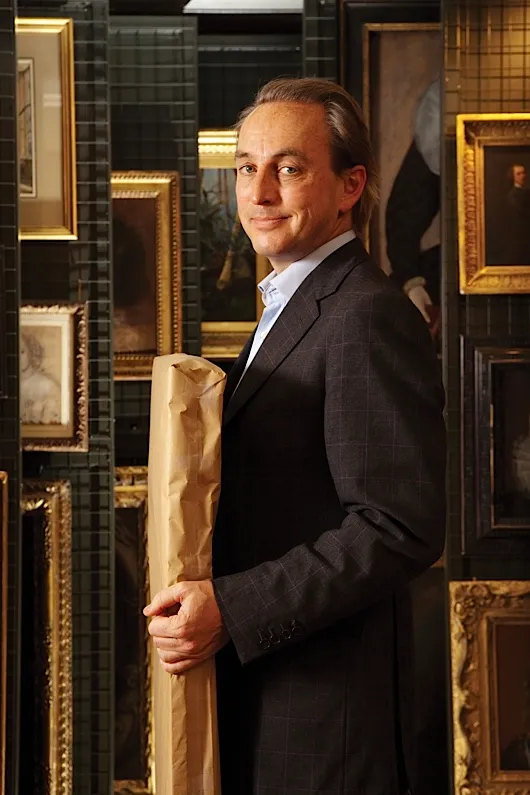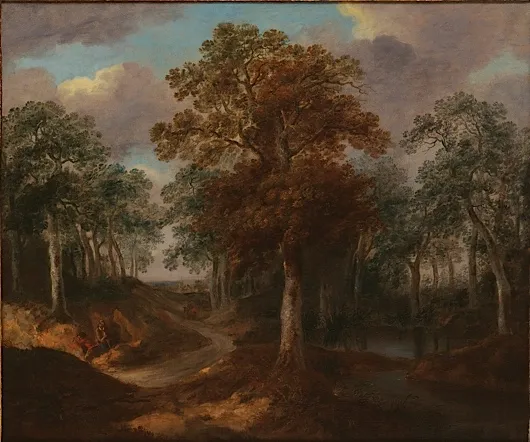It was November 2006 and, flipping through a sale catalogue from an LA auction house on my researcher Bendor Grosvenor’s desk, I came across a small colour illustration of a rustic woodland scene with figures. Catalogued ‘Follower of Jacob van Ruisdael’, it had an estimate of $2,000–$3,000.
But this was no normal imitator of the Dutch master. Everything about the illustration triggered feelings of familiarity. The composition hit me first. The weaving row of oaks, ashes and beeches, the pool of dark water and the pair of pickaxe-wielding labourers followed choreography I had seen before. So did the foliage – a melody of light and dark greens rendered in a shorthand that was instantly recognisable. OK, I thought, relax for a moment. Although this had the look of a master’s work, why not a good copyist instead?
I took a deep breath and gazed again at the image, this time employing as much jaundiced experience as I could muster. Come on, I told myself, seek out the weaknesses, the clumsiness, passages of crudeness or deadness; check the figures for their solidity – anything to stop my excitement from dissolving into fantasy. But this exercise only achieved the reverse. What now affected my breathing was that I recognised the artist and the subject. I dropped the catalogue in front of Bendor.
‘This little Dutch landscape – doesn’t it remind of you something?’ I asked. Adjusting his glasses, Bendor leaned forward. It took him only a few seconds to realise that he was surveying the familiar contours of Gainsborough’s Cornard Wood.
A love of landscape
Born in Sudbury in 1727, Thomas (known as Tom) Gainsborough was a prolific sketcher with a deep attachment to the Suffolk landscape. Around the age of 14, after his talents were recognised, Tom left Sudbury for London. Within a few years he was, along with Sir Joshua Reynolds, the most successful portrait painter in England. Landscape remained his first love, however, and one painting above all others, which he completed in 1748 while living and working in Ipswich, monumentalised this proclivity.

Now hanging in the National Gallery, it is a large canvas, around 4ft high and 5ft across and, although Gainsborough self-deprecatingly described it as not one of his ‘riper performances’, it is a ravishing panorama of detail and atmosphere. The subject portrayed is a wood, its trees recorded with relish and its glades and clearings scattered with little incidents. A rustic is digging marl and making eyes at his lover; another figure gathers wood; a pair of donkeys exchange companionable looks and, in the dim distance, the spire of a church can be seen. Its location is a dense patch of wood in a neighbouring parish a few miles from the artist’s boyhood home. Its name is Cornard Wood (pictured above).
It was three days before the sale and I woke up with thoughts of Cornard Wood pulsating through my head. The previous evening Bendor and I had taken a closer look at the catalogue picture on his screen and, although I had not been able to determine its condition, we were now convinced of two things: it was an early work by Thomas Gainsborough and, although more than half the size of the National Gallery picture, it was definitely of Cornard Wood.
Hard-bitten experience has shown me that to re-present this painting as a newly discovered Gainsborough, we’d have to place it within the context of the artist’s development. Find the missing pieces and we had the potential to turn an anonymous Dutch oil 5,000 miles from home into a footnote of British landscape history.
Passport to London
On this type of occasion the day’s agenda sets itself. Bendor dropped everything to read all published material on the picture, in particular anything that might reference another painting of the same title. Meanwhile, I cancelled appointments and headed off to the National Art Library in search of an extremely scarce memoir of Gainsborough by Philip Thicknesse, who claimed to have discovered the artist.
‘Funny that, for a rare book,’ said the young librarian. ‘You’re the second person this week to ask for it.’ Here we go, I thought, with a silent groan – often the only way you know that others are on to a sleeper is the evidence of activities similar to your own. When the book was finally delivered into my hands after an agonising wait, I leafed through it until I found a reference to Gainsborough's boyhood jottings: ‘The first effort… is a group of trees… such as would not be unworthy of a place… in one of his best landscapes,’ wrote Thicknesse.

When I returned to my office, Bendor had deposited the book I intended to go to next: The Letters of Thomas Gainsborough by Dr John Hayes, an authority on the artist. In it, in a letter dated 11th March 1788, Gainsborough writes of Cornard Wood: ‘This picture was… painted in Sudbury, in the year 1748: it was begun before I left school… and was the means of my father sending me to London.’
As I considered this apparent paradox – Tom left for London in 1741 – I realised that ‘begun’ must refer not to the moment he embarked on the big canvas but the moment he started working towards the idea. And for the work to have been sufficiently impressive to launch him on to the London scene, it was likely to be more than mere sketches. Why could he not have produced an oil painting, a work of startling precocity, that became not just his passport to London but the first stage towards his rural masterpiece?
Looking for proof
An obvious question that would hover over this picture if we bought it would be: what proof was there, apart from the anecdotal, that Gainsborough was painting so young? A controversial scholar, Adrienne Corri, had addressed the same issue a thousand times. I telephoned her the following day, the morning of the sale.
‘Ledgers at the Bank of England indicate that the first money from Fonnereau (an Ipswich businessman she claimed gave Tom his ‘first chance’) to Gainsborough was in 1736 – when he was 10 years old,’ she told me briskly down the phone. ‘How much?’ I asked. ‘The hefty amount of £300,’ she replied.
Final preparations
At a dinner party that evening, I had the warm feeling that we were as prepared as we could be. A telephone line had been booked and confirmed with the auction house. Our dollar holdings had been checked and Bendor, whom the auctioneers had been instructed to phone for the bid, had arranged to stay late in the gallery. My mobile sat between my legs, discreetly turned to vibrate as back-up if they could not reach Bendor. If all else failed, Lottie Tate, my long-serving gallery manager, was ready on the end of a phone on a farm in Lincolnshire.
Despite all this, 10 minutes into excitedly relating the story, I started to feel anxious. Some of the smaller auction houses are not as efficient as they might be and disasters do happen. International lines can become engaged, digits can be misread, instructions lost, and all these misadventures, at some time or another, have befallen us.
I was also concerned about what to bid. If this turned out to be a work of quality, in good condition, then it would be worth £400,000. If it turned out to be a late copy, a mere £1,000. Weighing up the possible downsides, I had told Bendor to bid to no more than $110,000 including commission. But now, appreciating for the first time the painting’s emotive power as its allure spread across the dinner table, I realised I had made a mistake. Given the picture’s prospective importance, why the hell was I not bidding myself?
At that moment my seat vibrated. Leaping up, I clumsily made for the sanctuary of the kitchen with the phone to my ear.
‘You can sack me if you want,’ said Bendor in an assured voice on the other end. My God, I thought. He has failed to bid. ‘What do you mean?’ I whispered. ‘The picture made approximately $120,000 in all – $10,000 more than the limit,’ he replied impassively.
My worst fear now rose. I had not given him enough. ‘So who bought it?’ I fretted. ‘That’s what I mean,’ said Bendor. ‘Fire me if you will. I took it on. We bought it.’ Thinking about it later, I don’t think he had any intention of sticking to my limit.
Youthful precursor
A fortnight later, we were in our weekly meeting when the picture was delivered. As Bendor and I cut and tore at the bubblewrap, I glimpsed a corner of the carved and gilded period frame - a good start, I thought. The next foretaste was a flash of green foliage. Even better, I felt, noticing a telltale swipe of glaze on its fringes. As Bendor removed the final layer, the dusty underside was revealed, where, amid the scribbled chalk auction numbers, there was a label for the London art dealers Agnew’s, trading since 1817. We craned forward. Beneath the company logo was some faded ink writing. ‘Cornard Wood,’ it read. It seemed the auction house had not heeded the most obvious clue available.

Three months later, we arrived at the National Gallery to view our painting (pictured above) – now cleaned, relined and restored – next to Cornard Wood in the gallery’s conservation studio. For myself and others there that day, it was a moment of memorable poignancy. On the left was the great operatic masterpiece, one of the most admired productions of its day, its panoramic glamour and rustic observations working their magic on us as they had done on others over the past 250 years. On the right, something altogether meeker and less contrived, but inextricably linked: a youthful precursor of the great things to come. A sleeper had awoken as satisfactorily as it could do in my lifetime.
This is an edited extract from Sleuth by Philip Mould, published by HarperCollins.